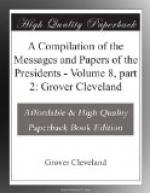Her Majesty’s Government feel an unabated desire to bring the long-pending questions connected with the boundary between the United States and the British possessions in North America to a final and satisfactory settlement, being well aware that questions of this nature, as long as they remain open between two countries, must be the source of frequent irritation on both sides and are liable at any moment to lead to events that may endanger the existence of friendly relations.
It is obvious that the questions at issue between Great Britain and the United States must be beset with various and really existing difficulties, or else those questions would not have remained open ever since the year 1783, notwithstanding the frequent and earnest endeavors made by each Government to bring them to an adjustment; but Her Majesty’s Government do not relinquish the hope that the sincere desire which is felt by both parties to arrive at an amicable settlement will at length be attended with success.
The best clew to guide the two Governments in their future proceedings may perhaps be obtained by an examination of the causes of past failure; and the most prominent amongst these causes has certainly been a want of correct information as to the topographical features and physical character of the district in dispute.
This want of adequate information may be traced as one of the difficulties which embarrassed the Netherlands Government in its endeavors to decide the points submitted to its arbitration in 1830. The same has been felt by the Government in England; it has been felt and admitted by the Government of the United States, and even by the local government of the contiguous State of Maine.
The British Government and the Government of the United States agreed, therefore, two years ago that a survey of the disputed territory by a joint commission would be the measure best calculated to elucidate and solve the questions at issue. The President proposed such a commission and Her Majesty’s Government consented to it, and it was believed by Her Majesty’s Government that the general principles upon which the commission was to be guided in its local operations had been settled by mutual agreement, arrived at by means of a correspondence which took place between the two Governments in 1837 and 1838. Her Majesty’s Government accordingly transmitted in April of last year, for the consideration of the President, the draft of a convention to regulate the proceedings of the proposed commission. The preamble of that draft recited textually the agreement that had been come to by means of notes which had been exchanged between the two Governments, and the articles of the draft were framed, as Her Majesty’s Government considered, in strict conformity with that agreement.
But the Government of the United States did not think proper to assent to the convention so proposed.




